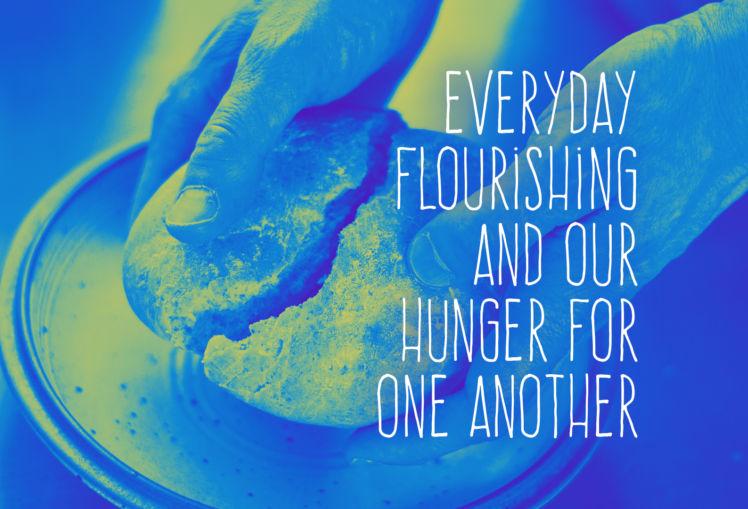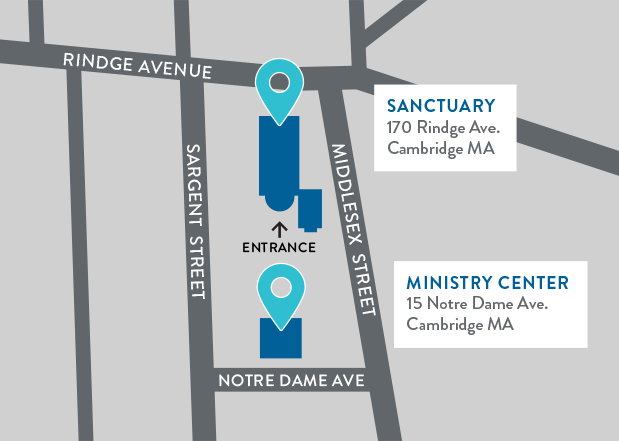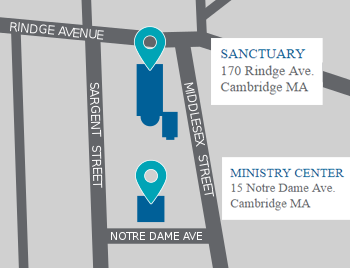Blog

Everyday Flourishing and our Hunger For One Another
September 21, 2018
Ivy Anthony
Recently we asked our congregation, “what is one of your deepest fears?” The response was varied, as one might guess – however, there were a cluster of answers that centered around the theme of loneliness; “I’m fearful of being alone”, “I’m afraid of dying alone”, “I’m afraid I’ll never find someone who I truly connect with”.
It seems that much of these fears are a reflection of our ever-growing disconnected society. And not only is “I’m afraid of being alone” an answer that comes from an unknown point in our future; it’s also a sentiment that 1 in 4 Americans feel now**. A quarter of Americans say that they have no one to talk to, including their family, about their troubles or triumphs.
For me this data is heart-stopping and is fodder for even more central questions to how we live in this world. Where are we? Where are people finding connection? A sense of belonging? How is it that we find meaning, and flourish in this day and age?
These questions are at the heart of Angie Thurston and Casper ter Kuile’s work in their study, How We Gather, which takes a long look at what is happening among millennials, 1 in 3 whom answer “none of the above” when asked to name their religious identity. In fact with nearly 3,500 Christian churches closing* across the country each year we know this is a conversation happening far beyond church walls – one that permeates the human soul regardless of religious affiliation. And yet flourishing is often highly attributed to a sense of deep meaning, purpose and connection – so how is it that we pursue flourishing amidst such widespread disconnection in our world?
We are made for connection, and it seems our souls and bodies suffer without it. Kuile points out that loneliness is a greater cause of death than obesity. And yet, millennials are seeking and creating new ways of finding meaning and purpose where they haven’t been able to find it. Thurston and Kuile’s study reflects the rise of unexpected, spiritual communities that fall outside of the realm of religion. Our hunger for connection, it seems, is a driving force for new creations: Fitness communities like Cross-Fit, Soul-cycle and yoga for instance are hugely popular. And while it would appear that people only go to these space for help in shaping their bodies – Thurston and Kuile’s study shows that many people end up staying for this sense of flourishing, found through a deep sense of community. This connection helps shape not only their bodies, but who they are and how they show up in the world as well.***
The Birthplace of Flourishing
A few weeks ago I was watering at our local school gardens. I was feeling mostly annoyed that I had to carve space for this in my busy day. But out of the corner of my eye I spotted an older woman, likely in her 70s, coming toward me. In great human-fashion I tried to not make eye contact, hoping that she was angling for someone else. Quickly though it was apparent that she was trying to get my attention; “Can you help me? Excuse me! Can you help me, please?”
I turned and saw that she was carrying a large piece of a lawnmower in her hands. She explained that she had been trying to get the grass collection bag over the handles, for quite some time but was unsuccessful on her own. We wrestled for the next few minutes to get the piece connected and in that short, divine window I gained a more expansive view of what flourishing can be. I learned about her life, her grown kids, how her hands use to be so much stronger, how she mows her lawn every week, how she loves watching kids walk by her house to school, how the guy on the phone from the hardware store advised her to “turn the lawnmower bag inside out to correctly put it on”.
If flourishing at its core is about belonging and becoming, then my hope is that the intersectionality of where I encounter God and where I encounter people is the birthplace of flourishing. We are yearning and eager to be seen and known and included. And we are quick to sniff out spaces that offer falsities or too much baggage to sift through. Perhaps this is why gyms and dinner tables and meet-up spots are more palatable than churches these days. There’s no pretense, no history — only the possibility of connection through ordinary life that feels accessible.
About mid-way through my assembly of this lawnmower with this 70-year old woman, I noticed that we were putting the grass bag on completely wrong (despite the hardware store dude’s advice on the phone). But I didn’t want to stop the process and correct it. I wanted to follow this error all the way through, until we both realized it together and had to re-calibrate and start the process all over again together. I wanted more time to laugh at us struggling to make sense of the plastic snaps, and more time to hear the grunts and groans as we tugged and pulled, and more time to watch our hands together – strong and weak, old and young(ish) – create something together, even though in the end it was completely nonfunctional. I realized in that moment on the sidewalk, lawnmower in hand, that I had found a living, breathing sanctuary in the form of another human being, and I wanted to stay in that sacred space.
It seems as though flourishing is less a linear process to a triumphant goal of air squats or kettlebell raises, and more a discover: found in our sweaty, mistake ridden, messy, sometimes inside-out kind of lives. Flourishing erupts in our hearts as we run to each other and say, “excuse me, can you help me?”
Paidrag O’ Tuama is an Irish poet and theologian who leads the Corrymeela community of Northern Ireland — a place that has offered refuge and healing since the country’s violent division. O’Tuama says that “belonging creates and undoes us both”. This lawnmower woman undid me. In that shared moment, I felt joy, I felt strength, I felt connectedness, I felt time sharpen and slow, allowing me to notice elements that I never would have otherwise. And I felt sparks of flourishing in side of my soul that ignited a sense of depth and new creation exactly where I stood.
Take, Bless, Break, Give and Repeat.
I’m sure that Jesus is cheering all the cross-fitters and soul-cyclers in this world on with vigor. But I also think he’s cheering on all the rest of us, who might not have the $34 per class, or the flexibility of time, or the bodies that can enter such activity to flourish exactly where we are at — where we live, where we work, where we play, where we water gardens — by embracing a posture of connectedness with all those around us.
He invites and reminds us to do this, through these 5 ways of checking ourselves against loneliness, isolation and divisiveness and upholding flourishing in our lives:
These elements of the meal that Jesus shared with his closest friends on the eve of his death remind us that to flourish is a fully portable experience. They are an invitation to recognize that we are all part of one another, a part of this life that is meant to be shared, eaten, spoke and lived. Indeed: to flourish is to fully live.
-
- Take: take in the opportunities around you to connect with others, even if these moments seem somehow less meaningful, mundane or ordinary.(To Try: Look up and make eye contact when you are out and about. Invite someone over for dinner that you never have. Or check out The People’s Supper for ways to join a table that you didn’t set!)
- Bless: Give thanks for all that you have. This appreciation extended to God, connects all things as fully divine and fully human.
- Break: Break rhythm, be willing to be disrupted. These moments of surrender, in our lives makes space for flourishing to set up and spread in our beings.
- Give: We are given by God to our spaces that we inhabit – to this life – to one another. And so may we keep giving of ourselves to one another – for the continuing process and creation of connection.
- Repeat: Do this again and again. Keep seeking each other to create and set new patterns. But repeat this with as much forward motion as you can, together with an expectation of creative production which pushes you ahead and produces as it repeats.
- Take: take in the opportunities around you to connect with others, even if these moments seem somehow less meaningful, mundane or ordinary.(To Try: Look up and make eye contact when you are out and about. Invite someone over for dinner that you never have. Or check out The People’s Supper for ways to join a table that you didn’t set!)
Do all this not only in remembrance of a living God who cheers on your flourishing; do this also with the belief that today, wherever you stand, you are ready to be turned inside-out as you share this messy life with the ones near you. You are ready to find God in the living, breathing sanctuary of another. This might just be the ticket to satiating our hunger for one another.
* Shawna Anderson, Jessica Hamar Martinez, Catherine Hoegeman, Gary Adler and Mark Chaves, “Dearly Departed: How Often Do Congregations Close?”, Journal for the Scientific Study of Religion, 2008, 47:321-328. Of course there are exceptions to the rule, including non-denominational Christian churches like Trinity Grace Church in New York City and Soul City Church in Chicago and hipster-friendly Soho Synagogue in lower Manhattan, which are growing among Millennials.
* Shawna Anderson, Jessica Hamar Martinez, Catherine Hoegeman, Gary Adler and Mark Chaves, Dearly Departed: How Often Do Congregations Close?, Journal for the Scientific Study of Religion, 2008, 47:321-328. Of course there are exceptions to the rule, including non-denominational Christian churches like Trinity Grace Church in New York City and Soul City Church in Chicago and hipster-friendly Soho Synagogue in lower Manhattan, which are growing among Millennials.

